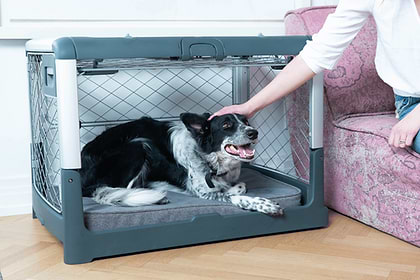The prospect of bringing a new dog home to another dog can seem daunting to pet parents, but there are a lot of steps you can take to make the transition easier on everyone. First, you are going to want to consider your dogs’ individual personalities.
If your dog’s behavior tends to be on the shyer side, understand that they might need a bit more time to open up after the first meeting.
Meanwhile, a dog who seems to befriend every friend, family member, and stranger they meet might feel comfortable faster. Both of these personalities and any in between are capable of enjoying life with other dogs; they just have their own needs that must be considered.
1. What To Do if Your Dog Does Not Like Other Dogs
As any dog trainer or behaviorist will tell you, there are also some dogs who simply do not get along with other canines. These dogs may not do as well with a new pet due to their limited social skills. They might tend to growl when you go near their food bowls or dog toys and even lunge at resident dogs in your neighborhood.
This aspect of your dog’s personality could stem from not having been properly socialized as a puppy, or perhaps they had some kind of negative first impression with a dog along the way. No matter the reason, you need to have realistic expectations of what is possible for your dog — especially an older dog.
If your pet feels seriously uncomfortable when face-to-face with other dogs, introducing a new dog into your life together is likely not a wise plan. There are methods that you can employ to help your dog feel more confident and friendly, but they might not ever get to the point where living with another dog would work.
As long as you have realistic expectations, no one will end up disappointed. Introduce them to other dogs slowly, and know when to pull back rather than push. It is possible that your dog will never enjoy the company of other dogs, and that is perfectly acceptable.
Pushing them too far out of their comfort zone will not help your dog feel more comfortable. Instead, this will simply foster more negative associations with their fellow dogs, making the negative cycle even harder to break.
2. How To Deal With a Dog Who Is More Energetic Than Another
Introducing dogs to each other takes patience and understanding above all else. Also, be aware that some dogs might have more compatible personalities than others. If two dogs are quite energetic, then it is more likely that they will make excellent playmates. However, if one dog prefers to snooze on the couch, they might not appreciate another pet’s constant attempts to instigate playtime.
In order to create the best possible circumstances between the two dogs, try to lower the excitable one’s energy level as much as possible before introducing the two. This could take the form of some vigorous walks throughout the day, or a rousing game of fetch or two. By tiring out this dog, they will present with much calmer energy that will be less intimidating.
One dog’s attempt to play could read as threatening or intimidating to another. Even if that was not the intention behind a dog’s actions, this could result in much more difficulty getting them comfortable with each other. Over time, these two pets could become best friends and enjoy playing together, but it is best to start out in a calmer environment.
3. Make Their First Introduction on Neutral Ground
Whether you are bringing a new dog into your home and life, or if you are just introducing your current dog to a new friend, this step is crucial. If you bring a dog into a space that already smells like another animal, they are likely to feel uncomfortable and not at ease. At the same time, the dog whose house it is might get territorial, and feel like their space is being infringed upon.
To avoid all of this discomfort, introduce these two dogs in a place that has neither of their smells already. Generally speaking, these introductions are also better done outdoors.
Outside, there is more space for them to interact or to seek out other stimuli if they want to. Small, enclosed spaces could force them to be near each other before they are ready, which is not an ideal situation for anyone.
This brings us to our next tip…
4. Go at Your Dogs’ Pace
When you are introducing two dogs to one another, it can be easy to grow impatient. It is crucial to resist the urge to hurry the dogs up, as this will just make them uncomfortable and possibly harm the long-term strength of the relationship. Go as slowly as your dogs want to and never force them to do anything before they are completely ready.
More outgoing dogs might try to sniff or inspect another pet nearly instantly, while other dogs might need more time before they are ready. Both of these responses are completely legitimate, but it is always best to err on the side of caution. If one dog is not quite ready, then go with that.
5. Supervise All of the Dogs’ Interactions With Each Other
Keeping both dogs on leash is perhaps the best way to monitor their interactions with one another. If they are on a leash, then both you and someone else can easily remove the dogs from the situation if things were to get heated, or if a dog felt uncomfortable. How will you know if your dog is feeling comfortable or not? We are so glad you asked.
Watch Their Body Language
As time goes on, pet parents will get to know their pets’ body language like the back of their hands. Since dogs cannot speak to us, body language is the most effective means we have of determining how our pets feel. If your dog begins growling or whining, or if they show different signs of submission or fear, it is time to separate them.
Aggression is sometimes a fear response (fear or anxiety-related aggression), so you should look for a few different postures and facial expressions to figure out how your dog is feeling. If you see any of the following, your dog might be stressed:
- Your dog is crouched toward the ground
- Their tail is raised and possibly twitching
- They bare their teeth
- Your dog makes direct eye contact with other dogs
6. Take the Dogs on a Walk Together
Once your dogs have had a pleasant interaction together on neutral ground, you can now take them on a walk. They should each be on their own leash, held by two different people so that they can maintain a bit of distance from one another.
This way, they can each get some exercise in a fun way, and associate the other dog with pleasant activities. However, each dog has their own personal space so that they never feel like their territory is in danger.
7. Give Each Dog a Space That Is Just Theirs
Many pet parents have discovered the benefits of crate training their dogs. Dogs love to spend time in their crates, as these spaces inspire their natural denning instincts, creating feelings of comfort and safety. Once another dog is in the picture, though, you need to make sure that they both are given their own space.
By crate training your dogs, you can also rest assured that you have a backup plan to separate them. If needed, you can always tell your dogs to go back to their crates, therefore giving them some distance from each other.
8. Never Let Jealousy Play a Role
On a similar note to our last tip, you are going to want to make sure to have two of everything. Your dogs will need their own crates to hang out in, but they will also need their own food dishes, water bowls, and toys. If you do not ensure that each dog has access to what they want at the moment, then they could easily become jealous of each other.
For instance, if there is one chew toy that is particularly beloved by both animals, you should absolutely invest in another one. Then, when one dog is playing with that toy, you can give the other toy to the other dog. This will prevent any jealousy from arising between your pets and will maintain a positive environment for everyone involved.
If your dogs come to the realization that the presence of another pet means that they get fewer toys and less attention, they will understandably not be very happy. Getting (at least) two of everything is an important part of the preparatory process before bringing a new dog home to live with you and your current dog.
Every Dog Is Different
Understand each dog’s limits and boundaries and tend to their needs however you can. As long as you are patient with each dog, and you never try to push them too hard, you can create positive experiences.
Sources:
Socializing a New Puppy | Pets WebMD
Understanding Dog Body Language: Decipher Dogs’ Signs & Signals | American Kennel Club

The Diggs Team
We believe our dogs deserve safer, better designed pet products.
You might also like
Crate training tips, stories and inspiration
View all blogsIn Your Diggs
Share your photos with #DiggsPet and tag us @DiggsPet on IG and TikTok.



